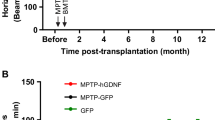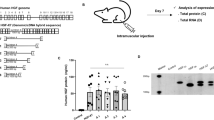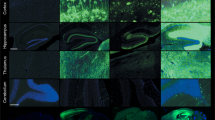Abstract
We have recently shown that intrastriatal injection of recombinant human erythropoietin (EPO) protects dopaminergic (DA) neurons in the substantia nigra (SN) from 6-hydroxydopamine (6-OHDA) toxicity in a rat model of Parkinson's disease. However, systemic administration of EPO did not protect nigral DA neurons, suggesting that the blood–brain barrier limits the passage of EPO protein into the brain. In the present study, we used an adeno-associated viral (AAV) serotype 9 (AAV9) vector to deliver the human EPO gene into the brain of 6-OHDA-lesioned rats. We observed that expression of the human EPO gene was robust and stable in the striatum and the SN for up to 10 weeks. EPO-immunoreactive (IR) cells were widespread throughout the injected striatum, and EPO-IR neurons and fibers were also found in the ipsilateral SN. Enzyme-linked immunosorbent assay and western blot analyses exhibited dramatic levels of EPO protein in the injected striatum. As a result, nigral DA neurons were protected against 6-OHDA-induced toxicity. Amphetamine-induced rotational asymmetry and spontaneous forelimb use asymmetry were both attenuated. Interestingly, we also observed that intrastriatal injection of AAV9-EPO vectors led to increased numbers of red blood cells in peripheral blood. This highlights the importance of using an inducible gene delivery system for EPO gene delivery.
This is a preview of subscription content, access via your institution
Access options
Subscribe to this journal
Receive 12 print issues and online access
$259.00 per year
only $21.58 per issue
Buy this article
- Purchase on Springer Link
- Instant access to full article PDF
Prices may be subject to local taxes which are calculated during checkout






Similar content being viewed by others
References
Csete M, Rodriguez L, Wilcox M, Chadalavada S . Erythropoietin receptor is expressed on adult rat dopaminergic neurons and erythropoietin is neurotrophic in cultured dopaminergic neuroblasts. Neurosci Lett 2004; 359: 124–126.
Morishita E, Masuda S, Nagao M, Yasuda Y, Sasaki R . Erythropoietin receptor is expressed in rat hippocampal and cerebral cortical neurons, and erythropoietin prevents in vitro glutamate-induced neuronal death. Neuroscience 1997; 76: 105–116.
Demers EJ, McPherson RJ, Juul SE . Erythropoietin protects dopaminergic neurons and improves neurobehavioral outcomes in juvenile rats after neonatal hypoxia-ischemia. Pediatr Res 2005; 58: 297–301.
Genc S, Kuralay F, Genc K, Akhisaroglu M, Fadiloglu S, Yorukoglu K et al. Erythropoietin exerts neuroprotection in 1-methyl-4-phenyl-1,2,3,6-tetrahydropyridine-treated C57/BL mice via increasing nitric oxide production. Neurosci Lett 2001; 298: 139–141.
Signore AP, Weng Z, Hastings T, Van Laar AD, Liang Q, Lee YJ et al. Erythropoietin protects against 6-hydroxydopamine-induced dopaminergic cell death. J Neurochem 2006; 96: 428–443.
Xue YQ, Zhao LR, Guo WP, Duan WM . Intrastriatal administration of erythropoietin protects dopaminergic neurons and improves neurobehavioral outcome in a rat model of Parkinson's disease. Neuroscience 2007; 146: 1245–1258.
Choi-Lundberg DL, Lin Q, Chang YN, Chiang YL, Hay CM, Mohajeri H et al. Dopaminergic neurons protected from degeneration by GDNF gene therapy. Science 1997; 275: 838–841.
Kirik D, Rosenblad C, Bjorklund A, Mandel RJ . Long-term rAAV-mediated gene transfer of GDNF in the rat Parkinson's model: intrastriatal but not intranigral transduction promotes functional regeneration in the lesioned nigrostriatal system. J Neurosci 2000; 20: 4686–4700.
Mandel RJ, Spratt SK, Snyder RO, Leff SE . Midbrain injection of recombinant adeno-associated virus encoding rat glial cell line-derived neurotrophic factor protects nigral neurons in a progressive 6-hydroxydopamine-induced degeneration model of Parkinson's disease in rats. Proc Natl Acad Sci USA 1997; 94: 14083–14088.
Kordower JH, Emborg ME, Bloch J, Ma SY, Chu Y, Leventhal L et al. Neurodegeneration prevented by lentiviral vector delivery of GDNF in primate models of Parkinson's disease. Science 2000; 290: 767–773.
Puskovic V, Wolfe D, Wechuck J, Krisky D, Collins J, Glorioso JC et al. HSV-mediated delivery of erythropoietin restores dopaminergic function in MPTP-treated mice. Mol Ther 2006; 14: 710–715.
Yamada M, Oligino T, Mata M, Goss JR, Glorioso JC, Fink DJ . Herpes simplex virus vector-mediated expression of Bcl-2 prevents 6-hydroxydopamine-induced degeneration of neurons in the substantia nigra in vivo. Proc Natl Acad Sci USA 1999; 96: 4078–4083.
Bankiewicz KS, Forsayeth J, Eberling JL, Sanchez-Pernaute R, Pivirotto P, Bringas J et al. Long-term clinical improvement in MPTP-lesioned primates after gene therapy with AAV-hAADC. Mol Ther 2006; 14: 564–570.
Mandel RJ, Manfredsson FP, Foust KD, Rising A, Reimsnider S, Nash K et al. Recombinant adeno-associated viral vectors as therapeutic agents to treat neurological disorders. Mol Ther 2006; 13: 463–483.
Jooss K, Chirmule N . Immunity to adenovirus and adeno-associated viral vectors: implications for gene therapy. Gene Therapy 2003; 10: 955–963.
Lowenstein PR, Mandel RJ, Xiong WD, Kroeger K, Castro MG . Immune responses to adenovirus and adeno-associated vectors used for gene therapy of brain diseases: the role of immunological synapses in understanding the cell biology of neuroimmune interactions. Curr Gene Ther 2007; 7: 347–360.
Broekman ML, Comer LA, Hyman BT, Sena-Esteves M . Adeno-associated virus vectors serotyped with AAV8 capsid are more efficient than AAV-1 or -2 serotypes for widespread gene delivery to the neonatal mouse brain. Neuroscience 2006; 138: 501–510.
Cearley CN, Wolfe JH . Transduction characteristics of adeno-associated virus vectors expressing cap serotypes 7, 8, 9, and Rh10 in the mouse brain. Mol Ther 2006; 13: 528–537.
Klein RL, Dayton RD, Tatom JB, Henderson KM, Henning PP . AAV8, 9, Rh10, Rh43 vector gene transfer in the rat brain: effects of serotype, promoter and purification method. Mol Ther 2008; 16: 89–96.
Klein RL, Dayton RD, Tatom JB, Diaczynsky CG, Salvatore MF . Tau expression levels from various adeno-associated virus vector serotypes produce graded neurodegenerative disease states. Eur J Neurosci 2008; 27: 1615–1625.
Bohl D, Salvetti A, Moullier P, Heard JM . Control of erythropoietin delivery by doxycycline in mice after intramuscular injection of adeno-associated vector. Blood 1998; 92: 1512–1517.
Kessler PD, Podsakoff GM, Chen X, McQuiston SA, Colosi PC, Matelis LA et al. Gene delivery to skeletal muscle results in sustained expression and systemic delivery of a therapeutic protein. Proc Natl Acad Sci USA 1996; 93: 14082–14087.
Johnston J, Tazelaar J, Rivera VM, Clackson T, Gao GP, Wilson JM . Regulated expression of erythropoietin from an AAV vector safely improves the anemia of beta-thalassemia in a mouse model. Mol Ther 2003; 7: 493–497.
Rendahl KG, Quiroz D, Ladner M, Coyne M, Seltzer J, Manning WC et al. Tightly regulated long-term erythropoietin expression in vivo using tet-inducible recombinant adeno-associated viral vectors. Hum Gene Therapy 2002; 13: 335–342.
Rivera VM, Gao GP, Grant RL, Schnell MA, Zoltick PW, Rozamus LW et al. Long-term pharmacologically regulated expression of erythropoietin in primates following AAV-mediated gene transfer. Blood 2005; 105: 1424–1430.
Rudich SM, Zhou S, Srivastava R, Escobedo JA, Perez RV, Manning WC . Dose response to a single intramuscular injection of recombinant adeno-associated virus-erythropoietin in monkeys. J Surg Res 2000; 90: 102–108.
Ye X, Rivera VM, Zoltick P, Cerasoli Jr F, Schnell MA, Gao G et al. Regulated delivery of therapeutic proteins after in vivo somatic cell gene transfer. Science 1999; pp: 88–91.
Zhou S, Murphy JE, Escobedo JA, Dwarki VJ . Adeno-associated virus-mediated delivery of erythropoietin leads to sustained elevation of hematocrit in nonhuman primates. Gene Therapy 1998; 5: 665–670.
Klein RL, Dayton RD, Leidenheimer NJ, Jansen K, Golde TE, Zweig RM . Efficient neuronal gene transfer with AAV8 leads to neurotoxic levels of tau or green fluorescent proteins. Mol Ther 2006; 13: 517–527.
Bohl D, Naffakh N, Heard JM . Long-term control of erythropoietin secretion by doxycycline in mice transplanted with engineered primary myoblasts. Nat Med 1997; 3: 299–305.
Leist M, Ghezzi P, Grasso G, Bianchi R, Villa P, Fratelli M et al. Derivatives of erythropoietin that are tissue protective but not erythropoietic. Science 2004; 305: 239–242.
Paterna JC, Feldon J, Bueler H . Transduction profiles of recombinant adeno-associated virus vectors derived from serotypes 2 and 5 in the nigrostriatal system of rats. J Virol 2004; 78: 6808–6817.
Siren AL, Fratelli M, Brines M, Goemans C, Casagrande S, Lewczuk P et al. Erythropoietin prevents neuronal apoptosis after cerebral ischemia and metabolic stress. Proc Natl Acad Sci USA 2001; 98: 4044–4049.
Villa P, Bigini P, Mennini T, Agnello D, Laragione T, Cagnotto A et al. Erythropoietin selectively attenuates cytokine production and inflammation in cerebral ischemia by targeting neuronal apoptosis. J Exp Med 2003; 198: 971–975.
Liu R, Suzuki A, Guo Z, Mizuno Y, Urabe T . Intrinsic and extrinsic erythropoietin enhances neuroprotection against ischemia and reperfusion injury in vitro. J Neurochem 2006; 96: 1101–1110.
Digicaylioglu M, Lipton SA . Erythropoietin-mediated neuroprotection involves cross-talk between Jak2 and NF-kappaB signalling cascades. Nature 2001; 412: 641–647.
Brines ML, Ghezzi P, Keenan S, Agnello D, de Lanerolle NC, Cerami C et al. Erythropoietin crosses the blood-brain barrier to protect against experimental brain injury. Proc Natl Acad Sci USA 2000; 97: 10526–10531.
Ehrenreich H, Hasselblatt M, Dembowski C, Cepek L, Lewczuk P, Stiefel M et al. Erythropoietin therapy for acute stroke is both safe and beneficial. Mol Med 2002; 8: 495–505.
Wang Y, Zhang ZG, Rhodes K, Renzi M, Zhang RL, Kapke A et al. Post-ischemic treatment with erythropoietin or carbamylated erythropoietin reduces infarction and improves neurological outcome in a rat model of focal cerebral ischemia. Br J Pharmacol 2007; 151: 1377–1384.
Erbayraktar S, Grasso G, Sfacteria A, Xie QW, Coleman T, Kreilgaard M et al. Asialoerythropoietin is a nonerythropoietic cytokine with broad neuroprotective activity in vivo. Proc Natl Acad Sci USA 2003; 100: 6741–6746.
King VR, Averill SA, Hewazy D, Priestley JV, Torup L, Michael-Titus AT . Erythropoietin and carbamylated erythropoietin are neuroprotective following spinal cord hemisection in the rat. Eur J Neurosci 2007; 26: 90–100.
Klein RL, Dayton RD, Diaczynsky CG, Wang DB . Pronounced microgliosis and neurodegeneration in aged rats after tau gene transfer. Neurobiol Aging 2009 (In press).
Sauer H, Oertel WH . Progressive degeneration of nigrostriatal dopamine neurons following intrastriatal terminal lesions with 6-hydroxydopamine: a combined retrograde tracing and immunocytochemical study in the rat. Neuroscience 1994; 59: 401–415.
Ungerstedt U, Arbuthnott GW . Quantitative recording of rotational behavior in rats after 6-hydroxy-dopamine lesions of the nigrostriatal dopamine system. Brain Res 1970; 24: 485–493.
Schallert T, Fleming SM, Leasure JL, Tillerson JL, Bland ST . CNS plasticity and assessment of forelimb sensorimotor outcome in unilateral rat models of stroke, cortical ablation, parkinsonism and spinal cord injury. Neuropharmacology 2000; 39: 777–787.
Duan WM, Widner H, Brundin P . Temporal pattern of host responses against intrastriatal grafts of syngeneic, allogeneic or xenogeneic embryonic neuronal tissue in rats. Exp Brain Res 1995; 104: 227–242.
Duan WM, Widner H, Cameron RM, Brundin P . Quinolinic acid-induced inflammation in the striatum does not impair the survival of neural allografts in the rat. Eur J Neurosci 1998; 10: 2595–2606.
Acknowledgements
This study was supported in part by Eichler Award from the Parkinson's disease Resource of Northwest Louisiana, LEQSF(2008-11)-RD-A-15 and NSF(2008)-Pfund-104 from the Louisiana Board of Regents, Research grant from the American Parkinson Disease Association and the Louisiana Gene Therapy Research Consortium. We thank Dr David Knight for critical reading of the manuscript. We also acknowledge Ms Kathleen Llorens for her help in obtaining the confocal microscope images presented in this article.
Author information
Authors and Affiliations
Corresponding author
Rights and permissions
About this article
Cite this article
Xue, YQ., Ma, BF., Zhao, LR. et al. AAV9-mediated erythropoietin gene delivery into the brain protects nigral dopaminergic neurons in a rat model of Parkinson's disease. Gene Ther 17, 83–94 (2010). https://doi.org/10.1038/gt.2009.113
Received:
Revised:
Accepted:
Published:
Issue Date:
DOI: https://doi.org/10.1038/gt.2009.113
Keywords
This article is cited by
-
PEG-mediated transduction of rAAV as a platform for spatially confined and efficient gene delivery
Biomaterials Research (2022)
-
Current knowledge and challenges associated with targeted delivery of neurotrophic factors into the central nervous system: focus on available approaches
Cell & Bioscience (2021)
-
Emerging Technologies for Delivery of Biotherapeutics and Gene Therapy Across the Blood–Brain Barrier
BioDrugs (2018)
-
Systemic injection of AAV9-GDNF provides modest functional improvements in the SOD1G93A ALS rat but has adverse side effects
Gene Therapy (2017)
-
Transfection of primary brain capillary endothelial cells for protein synthesis and secretion of recombinant erythropoietin: a strategy to enable protein delivery to the brain
Cellular and Molecular Life Sciences (2017)



